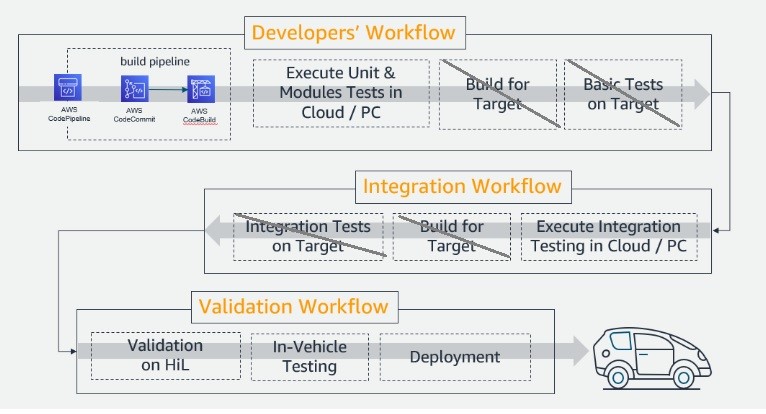
There is a current automotive industry paradigm shift that is requiring Original Equipment Manufacturers (OEMs) to accelerate their in-vehicle software delivery utilizing newer approaches and solutions such as cloud-based workflows and automotive operating systems (OS). Customer demand highlights the need for vehicles to be more connected, autonomous, shared, and electric (CASE). A McKinsey report says 95% of new vehicles sold in 2030 will be connected, 64% of customers would switch OEMs for better autonomous-driving capabilities, EU law will require all new cars sold to have zero emissions from 2035, and two out of three US customers expect their shared-mobility usage will increase over the next two years.
The move towards the software-defined vehicle (SDV) is the paradigm shift that OEMs and their suppliers are utilizing to build and support CASE-specific features such as digital cockpit (e.g. in-vehicle-infotainment, safety displays, and internal monitoring capabilities), advanced driver assist systems (ADAS), and autonomous driving (AD). With SDVs, OEMs and their suppliers can build and deliver customer-centric features via software updates at vehicle launch, and throughout the life cycle of the vehicle to match the driver and passenger needs. SDVs introduce new opportunities for customer loyalty, and OEM revenue. Not only does cloud-native SDV help enable efficient, scalable, and secure deployments, but also feature-rich capabilities that resonate with the vehicle owner and passengers. SDVs also bring challenges such as compliance and certifications, which must be handled.
In this blog post, we will explain how Elektrobit and AWS are working together to help accelerate automotive feature-rich development and deployment of code to vehicles. We will discuss how OEMs can use these advancements to help accelerate their SDV roadmap implementation.
The Value Stream, from Customer Demand to Delivery
We will describe Elektrobit and AWS solution capabilities in the context of the value stream that exists from customer demand to delivery. The following graphic depicts how vehicle owners and passengers experience personalized features and capabilities throughout the life cycle of their vehicle (from concept to end of life). Connected vehicles and modern electrical architecture elevate the SDV discipline to help enable the development and deployment of highly tailored experiences.

Each of the components shown in the diagram are described in detail below.
Delighting and inspiring products:
Customer satisfaction and loyalty will be won and retained through an evolving digital cabin experience that is integrated with software across various components in the vehicle. To make this possible, OEMs will need to transform the way they write and manage software. OEMs continue to focus on what makes their product experience unique. As vehicles become connected, there will be a new challenge in updating, adding features to already sold vehicles, and generally keeping this experience relevant for customers. This ambition will come with many challenges. The next four components will describe how OEMs can achieve this with Elektrobit, together in collaboration with AWS.
Cloud-first workflows:
SDVs are changing how we think about embedded software. Currently, the design, development, and unit test process rely on a physical rig. This poses two significant problems: 1) Production and R&D ECU availability is limited, therefore delaying the start of design and development, and 2) Hardware-in-the-Loop (HiL) is expensive to deploy, and even harder to collaborate across multiple time zones.
In order for OEMs to demonstrate their competitive advantage in the automotive industry, it will require a transformed engineering culture which is faster, more focused, yet nimble, and uses specific tools. An “always-on” cloud infrastructure can be utilized to achieve this, as it will help enable globally-distributed teams across the OEM to work more collaboratively and around the clock. Modernized workflows will include “always-on” cloud based agile development from globally distributed teams leveraging virtual assets to deliver the most important end-customer value quickly. Cloud-first workflows for DevOps, testing, analytics, and updates will be widely adopted. Elektrobit and AWS have worked together in this area to help OEMs accelerate their SDV implementations. We explain more about this in the “Shift Left” approach below.
Automotive OS:
An Automotive OS abstracts the complex network of ECUs of a vehicle as one device. It manages, supervises, and updates this one device. It enables more harmonized application programming interfaces (APIs) against which functions are developed. Automotive OS is one of the primary enablers for achieving SDV. Automotive OS accelerates cloud-first development and verification. Software suppliers must understand this important role of Automotive OS.
Elektrobit has a proprietary suite of comprehensive products based on classic and adaptive AUTOSAR, an open-source operating system for high-performance computing (EB corbos Linux), hypervisors, and products for secure and efficient in-vehicle network communication. These assets are becoming virtualized and available in the cloud.
Software Life cycle Management:
With the move towards SDVs, software code will define more features in the future vehicle. The number of lines of code is expected to increase from 100 million lines per vehicle to about 300 million lines by 2030. OEMs will also need to comply with the stringent automotive safety and security requirements. Both of these will push OEMs to increase the frequency of over-the-air (OTA) update cycles. OEMs will need help to develop software pipelines that help remediate security issues expediently.
Digital Life Experience:
The digital cabin experience becomes the key opportunity for OEMs to engage with their end customers. Elektrobit is a leader in IVI system design and implementation and is at the forefront of building systems with multiple displays and device profiles. New electrical architecture performance is superior as the IVI hardware and software come together. Elektrobit has created a reference IVI platform to supplement its existing middleware offerings. It connects Board Support Packages (BSPs) to common platforms such as Android, QNX, and AUTOSAR.
The “Shift Left” approach
Modern cars include 100 million lines of code and counting, and they need to be maintained throughout the life cycle of the vehicle. The magnitude of effort and cost required for OEMs to develop and maintain this software across all vehicle makes and models will be exorbitant, if the latest approaches and toolsets, such as cloud-native development and testing, are not utilized.
Cloud-native development is the virtualization of the electrical architecture and in-vehicle hardware. It enables software programmers to design, develop, and test vehicle features that humans interact with, at scale. Virtual ECUs can be utilized in the cloud to help overcome the lack of physically available R&D ECUs, and help enable real-time global collaboration. Such environmental parity provides the capability for the same Elektrobit software stack-based application that was developed and tested in the cloud, to be deployed to the vehicle.
What does scale mean? Key components of the vehicle’s electrical architecture can be virtualized in the cloud via virtual ECUs, and Controller Area Network (CAN) or Scalable service-Oriented MiddlewarE over IP (SOME/IP) protocol based virtual network, in minutes. Developers around the globe can collaborate to design, build features, test, and deploy more rapidly, and in real time. This helps enable multiple software programmer teams to work on many vehicle models in parallel. With a well-formed cloud governance structure, software code can be more easily catalogued, reused, and extended. Additionally, test and performance data can be more easily and inexpensively stored and retrieved. AWS’s years of experience in optimizing cloud infrastructure costs can be used to help create a more cost-effective solution.
The steps that have been crossed out in the diagram above help Shift Left into a cloud-based Software-in-the-Loop (SiL) testing.
Elektrobit was among the first supplier to offer a commercially available software implementation of Adaptive AUTOSAR and its scalable solutions, which are making it easier for OEMs to develop these advanced systems.
Elektrobit’s EB corbos Studio along with the already-on-the-road EB corbos AdaptiveCore stack are a core component of any future High-Performance Compute (HPC) development project. Combining Elektrobit’s assets with AWS cloud technology helps create a more efficient, faster application development, and easier testing. As an example, when deploying to ARM architecture-based ECUs in the vehicle, the software build that was tested on AWS Graviton ARM CPU-based cloud instances will work on the target ECUs without the need for code recompilation. EB corbos Hypervisor can support multiple virtual ECUs to be tested on a single cloud compute instance, while the most recent Eclipse Ankaios container orchestrator also contributes to scaling the AUROSAR applications by utilizing compute instances efficiently. Elektrobit’s comprehensive product portfolio with cloud integration enables testing at scale, which was previously not possible.
The Shift Left approach can help transform engineering processes, by enabling rapid agility. With the flexibility of cloud infrastructure, globally-distributed teams can work around the clock to deliver the highest-priority items first. Thus, new features can be pushed to drivers and passengers through cloud governance to more easily manage frequent update cycles and help improve OTA software update services.
While this blog described development and deployment of software to vehicles in the context of SDV, the principles presented highlight their applicability to the other CASE applications as well.
To draw a conclusion…
Elektrobit is utilizing AWS’s services and infrastructure to develop an industry-leading cloud-based virtual application development and testing solution suite. In this blog post, we described the benefits of Elektrobit’s product portfolio and Elektrobit’s integration with AWS services. By providing cloud-native development and testing solutions for all of its widely used in-production automotive software stack components, Elektrobit is uniquely positioned to help accelerate code-to-road for OEMs. Elektrobit expects the cloud-based Shift Left development and testing solution to support several thousand developers and testers spread across the globe, to develop and test in parallel.
We invite you to read more about Elektrobit’s EB corbos product here.
To learn about how AWS may lower the cost of software infrastructure, we invite you to experience a hands-on workshop here.
Authors bio:
Sorin Zamfir is a Product Manager at Elektrobit where he works with several teams to enable cloud development workflows in Automotive. Based in Brasov, in the center of Romania, Sorin started his automotive career about 9 years ago and has been involved in several projects ranging from infotainment to OTA products. In his spare time, he likes to read, enjoy good food and travel.
Dylan Dawson is Head of Partner Management for Elektrobit Americas and AWS Alliance Lead. Located in Seattle Washington, he draws from more than a decade of technical and business development experience to help grow Elektrobit’s partnership ecosystem. Dylan is passionate about the future of mobility and works to forge strategic results-driven relationships in the automotive landscape. When not at work, he enjoys time outdoors and trips to the local record shop.
Srini Raghavan is a Partner Solutions Architect at Amazon Web Services. He is responsible for the success and growth of many partners in the AWS automotive vertical, where he enables the strategic partners to build, market, and sell their mutual innovative solutions, while leveraging the power of AWS cloud. When not building solutions on AWS, he loves to run as well as follow Cricket (the sport).
Sandeep Shah works with global corporations to define, and lead transformational change. Sandeep leads change through hosting executive visioning sessions and “art of the possible” workshops, in addition to aligning business goals by developing technology roadmaps, and defining the strategy and implementation of globally operated Cloud Centers of Excellence. Outside AWS, Sandeep loves playing football (soccer), and coaches youth recreational.











